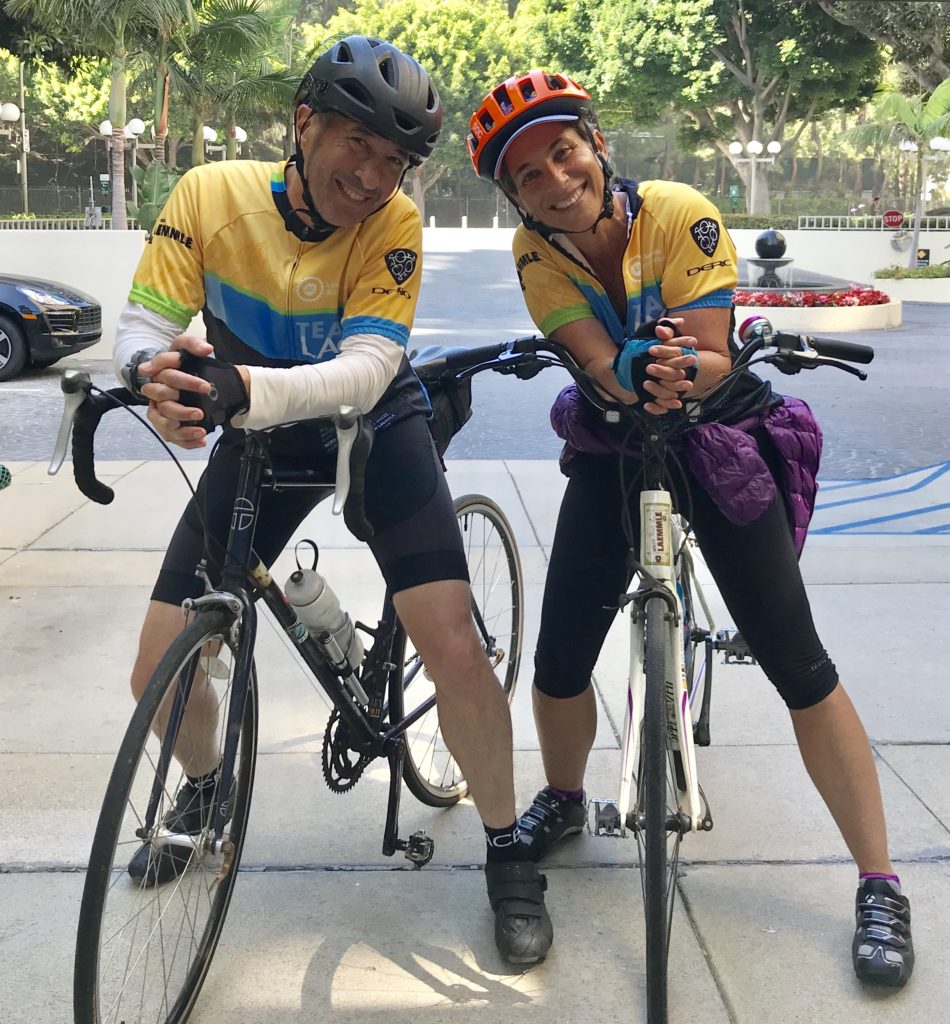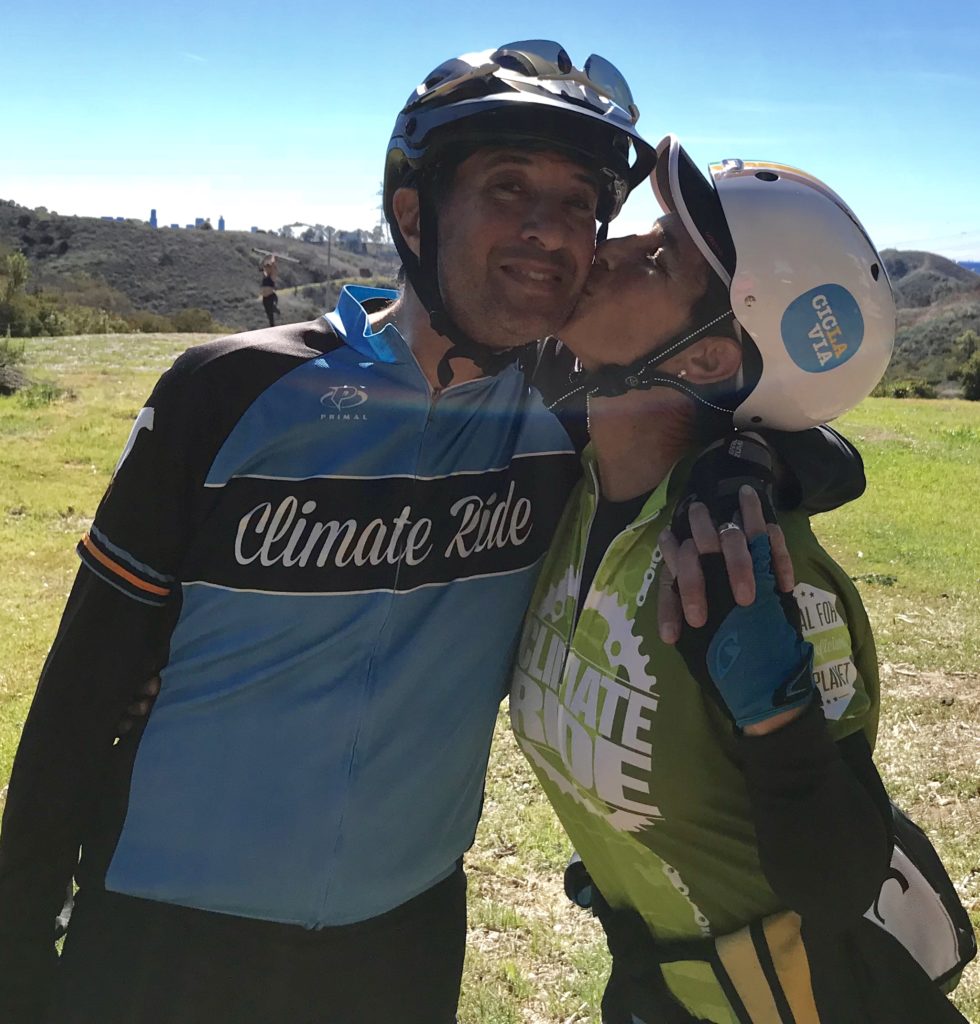
Tish and Greg Laemmle are a powerhouse couple who have been pedaling for the planet for years. Tish will be turning 60 this year, and says that riding the hills around LA “are not exactly easy for me.” Her solution? “TRAINING, TRAINING, TRAINING!!!” and a good goal to help motivate her. She chose a big one!
Last year she met her goal to be the highest fundraiser for Climate Ride 2018. She is also the highest single-event Climate Ride FEMALE fundraiser of all time, with over $25,000 in donations in 2018.
Greg is the first person to break the $100,000 total mark through his combined fundraising on all of his Climate Rides (he’s at $109,000 and climbing!). Clearly, they’re both very competitive people, fortunately just not with each other. They’ve channeled that competitive energy to do more for the city they love and the planet we all share. Cycling is a crucial piece in solving the climate puzzle, and these two have taken on helping one of the United States’ most traffic-congested cities become friendlier to biking.
When asked why she joined Climate Ride, Tish said it was for two main reasons: 1) Because our planet is sick and needs all the help it can get. 2) It’s one of the only ways to get her husband to take some time off!
According to the Laemmles, climate change is having a big impact on Southern California. The seasonal rains have never been that big in Southern California. But they were reliable. Now, it seems to them like drought conditions are more than the norm. And even just a few years ago, it was common to see snow-capped peaks on the mountains ringing the Los Angeles basin. Now, when storms do roll through, it is generally too hot for any precipitation to stick as snow. Recently, an article in the
Washington Post backed up what they have noticed, showing that the snow back over the last six years has typically been at historical lows. Climate change also means occasional bursts of historic high precipitation, rather than the steady reliable rains of the past. Unfortunately, these bouts of high snowfall and precipitation also mean problems for drinking water, as they threaten the water infrastructure that keeps taps flowing by overrunning dams and levees and blowing out safety channels. And the sudden bursts of rain on dry or recently burned terrain can also be devastating.
A California that is drier than ever is also prone
to more intense fires. In 2017, the Thomas Fire hit southern California in early December, quickly blazing over 50 square miles in under 12 hours. It became the largest fire in California history before it was extinguished. Even with that incredible burn off, 2018 brought more fires, including the Woolsey fire, which cut through 100,000 acres and killed 3 people. According to
Wired, these fires are fed by the unpredictable shifts in rainfall created by climate change. While California forests evolved to expect fire, they also evolved with predictable Autumn rainfall patterns that mitigated the burn and growth cycles. These patterns have shifted well outside of any historically natural norms and the plant species are not prepared. Additionally, population growth has pushed deeper into forested areas, creating more opportunities for human impact.
When the various disasters created by climate change come together, they can cascade into greater devastation. The 2018 mudslides in Montecito resulted in rivers of mud that killed 23 people. According to the
Santa Barbara Independent, this disaster was the result of all three of the most devastating aspects of climate change that California has faced coming together: severe drought led to plant die off and dry conditions which increased fire load. The recent fires in the region further destroyed protective tree growth, loosening the soil, so that when the record-setting rains hit (
another climate change fallout), the resulting mudslides were unprecedented.
Without changes in human behavior, these disasters will get worse.
Thankfully, there are committed Angelinos like Greg and Tish who are creating positive examples of taking action. For Greg, his commitment to bikes began because of another big issue in LA: air quality. To Greg, there’s no question that air quality isn’t helped by the city’s over-reliance on individual automobile trips. Greg became a bike commuter so that he could help take one car off the road, and so that he would make some small contribution toward reducing greenhouse gas emissions. He also wanted to show others that it is possible (and individually beneficial) to live in LA without a car.
Tish used to be a professional dancer, dance teacher, and choreographer. She is currently an art curator. But she also devotes much of her time and energy to cycling and climate activism. She is on the board of
CicLAvia, which is a non-profit organization that puts on 4-6 events per year. They close down streets to cars and open them up to cyclists, pedestrians, families, street performers, often attracting over 100,000 people. And this year, the substantial amount of money she has raised will go to the
Los Angeles County Bicycle Coalition(LACBC). Her goal is to help them implement as many bike lanes throughout Los Angeles County as possible.

Activism brought the Laemmles to Climate Ride, and activism has kept them coming back.
Greg first heard about Climate Ride from an article in the
Rails-to-Trails Conservancy magazine. At the time, Greg was a board member with the Los Angeles County Bicycle Coalition and was interested in having LACBC be one of the beneficiary organizations for Climate Ride. Some while later, he heard at a board meeting that they had been approved to join the list of beneficiaries and that some people had already signed up to ride on behalf of LACBC. Joining the team and becoming the Team Captain seemed like a great way to fulfill some of his board obligations.
Five years on, he cites Climate Ride as one of the reasons he has become more involved with local politics. Greg believes that what happens in DC is important, but he also thinks that “we can’t give up just because Congress or the President refuse to take these issues seriously. There’s so much we can do at the local and state level. Just over the past few years, LA has gotten serious about rapidly expanding its mass transit system. And at the state level, California is leading the nation (and the world) toward a post-carbon energy platform. Yes, we could do so much more if we were getting help at the Federal level, but we will make progress either way.”
Like many Climate Riders, Tish and Greg were activists before they ever signed up for a Climate Ride, and they’ve brought that eye for justice to the cycling community. Greg remembers being struck by the lack of ethnic diversity on his first couple Climate Rides. Working together with staff, funders at LACBC and Climate Ride, they recruited and supported participants so that Team LACBC would look more like the community that they represent. At the same time, they opened up their training series so that people could ride together and become stronger and more confident riders even if they weren’t riding on Climate Ride. Both of these initiatives have paid off in a huge way. Fellowship riders who got a stipend to ride the first time around have returned to participate and commit to handling their own fundraising. They’ve helped recruit other riders. And they’ve become more involved with advocating for better bike conditions in LA County and developing a more sane transportation plan for the region.
We are honored to have the Laemmles as part of our inspiring and solutions-driven alumni community. You’ll see them in 2019 on Climate Ride Adriatic and the ever-growing Team LACBC on Climate Ride California (they welcome new members!
Join them here). Find the Laemmles on a ride to feel the power of cycling and love of people and planet.

 Tish and Greg Laemmle are a powerhouse couple who have been pedaling for the planet for years. Tish will be turning 60 this year, and says that riding the hills around LA “are not exactly easy for me.” Her solution? “TRAINING, TRAINING, TRAINING!!!” and a good goal to help motivate her. She chose a big one!
Last year she met her goal to be the highest fundraiser for Climate Ride 2018. She is also the highest single-event Climate Ride FEMALE fundraiser of all time, with over $25,000 in donations in 2018.
Greg is the first person to break the $100,000 total mark through his combined fundraising on all of his Climate Rides (he’s at $109,000 and climbing!). Clearly, they’re both very competitive people, fortunately just not with each other. They’ve channeled that competitive energy to do more for the city they love and the planet we all share. Cycling is a crucial piece in solving the climate puzzle, and these two have taken on helping one of the United States’ most traffic-congested cities become friendlier to biking.
When asked why she joined Climate Ride, Tish said it was for two main reasons: 1) Because our planet is sick and needs all the help it can get. 2) It’s one of the only ways to get her husband to take some time off!
According to the Laemmles, climate change is having a big impact on Southern California. The seasonal rains have never been that big in Southern California. But they were reliable. Now, it seems to them like drought conditions are more than the norm. And even just a few years ago, it was common to see snow-capped peaks on the mountains ringing the Los Angeles basin. Now, when storms do roll through, it is generally too hot for any precipitation to stick as snow. Recently, an article in the Washington Post backed up what they have noticed, showing that the snow back over the last six years has typically been at historical lows. Climate change also means occasional bursts of historic high precipitation, rather than the steady reliable rains of the past. Unfortunately, these bouts of high snowfall and precipitation also mean problems for drinking water, as they threaten the water infrastructure that keeps taps flowing by overrunning dams and levees and blowing out safety channels. And the sudden bursts of rain on dry or recently burned terrain can also be devastating.
A California that is drier than ever is also prone to more intense fires. In 2017, the Thomas Fire hit southern California in early December, quickly blazing over 50 square miles in under 12 hours. It became the largest fire in California history before it was extinguished. Even with that incredible burn off, 2018 brought more fires, including the Woolsey fire, which cut through 100,000 acres and killed 3 people. According to Wired, these fires are fed by the unpredictable shifts in rainfall created by climate change. While California forests evolved to expect fire, they also evolved with predictable Autumn rainfall patterns that mitigated the burn and growth cycles. These patterns have shifted well outside of any historically natural norms and the plant species are not prepared. Additionally, population growth has pushed deeper into forested areas, creating more opportunities for human impact.
When the various disasters created by climate change come together, they can cascade into greater devastation. The 2018 mudslides in Montecito resulted in rivers of mud that killed 23 people. According to the Santa Barbara Independent, this disaster was the result of all three of the most devastating aspects of climate change that California has faced coming together: severe drought led to plant die off and dry conditions which increased fire load. The recent fires in the region further destroyed protective tree growth, loosening the soil, so that when the record-setting rains hit (another climate change fallout), the resulting mudslides were unprecedented.
Tish and Greg Laemmle are a powerhouse couple who have been pedaling for the planet for years. Tish will be turning 60 this year, and says that riding the hills around LA “are not exactly easy for me.” Her solution? “TRAINING, TRAINING, TRAINING!!!” and a good goal to help motivate her. She chose a big one!
Last year she met her goal to be the highest fundraiser for Climate Ride 2018. She is also the highest single-event Climate Ride FEMALE fundraiser of all time, with over $25,000 in donations in 2018.
Greg is the first person to break the $100,000 total mark through his combined fundraising on all of his Climate Rides (he’s at $109,000 and climbing!). Clearly, they’re both very competitive people, fortunately just not with each other. They’ve channeled that competitive energy to do more for the city they love and the planet we all share. Cycling is a crucial piece in solving the climate puzzle, and these two have taken on helping one of the United States’ most traffic-congested cities become friendlier to biking.
When asked why she joined Climate Ride, Tish said it was for two main reasons: 1) Because our planet is sick and needs all the help it can get. 2) It’s one of the only ways to get her husband to take some time off!
According to the Laemmles, climate change is having a big impact on Southern California. The seasonal rains have never been that big in Southern California. But they were reliable. Now, it seems to them like drought conditions are more than the norm. And even just a few years ago, it was common to see snow-capped peaks on the mountains ringing the Los Angeles basin. Now, when storms do roll through, it is generally too hot for any precipitation to stick as snow. Recently, an article in the Washington Post backed up what they have noticed, showing that the snow back over the last six years has typically been at historical lows. Climate change also means occasional bursts of historic high precipitation, rather than the steady reliable rains of the past. Unfortunately, these bouts of high snowfall and precipitation also mean problems for drinking water, as they threaten the water infrastructure that keeps taps flowing by overrunning dams and levees and blowing out safety channels. And the sudden bursts of rain on dry or recently burned terrain can also be devastating.
A California that is drier than ever is also prone to more intense fires. In 2017, the Thomas Fire hit southern California in early December, quickly blazing over 50 square miles in under 12 hours. It became the largest fire in California history before it was extinguished. Even with that incredible burn off, 2018 brought more fires, including the Woolsey fire, which cut through 100,000 acres and killed 3 people. According to Wired, these fires are fed by the unpredictable shifts in rainfall created by climate change. While California forests evolved to expect fire, they also evolved with predictable Autumn rainfall patterns that mitigated the burn and growth cycles. These patterns have shifted well outside of any historically natural norms and the plant species are not prepared. Additionally, population growth has pushed deeper into forested areas, creating more opportunities for human impact.
When the various disasters created by climate change come together, they can cascade into greater devastation. The 2018 mudslides in Montecito resulted in rivers of mud that killed 23 people. According to the Santa Barbara Independent, this disaster was the result of all three of the most devastating aspects of climate change that California has faced coming together: severe drought led to plant die off and dry conditions which increased fire load. The recent fires in the region further destroyed protective tree growth, loosening the soil, so that when the record-setting rains hit (another climate change fallout), the resulting mudslides were unprecedented.

